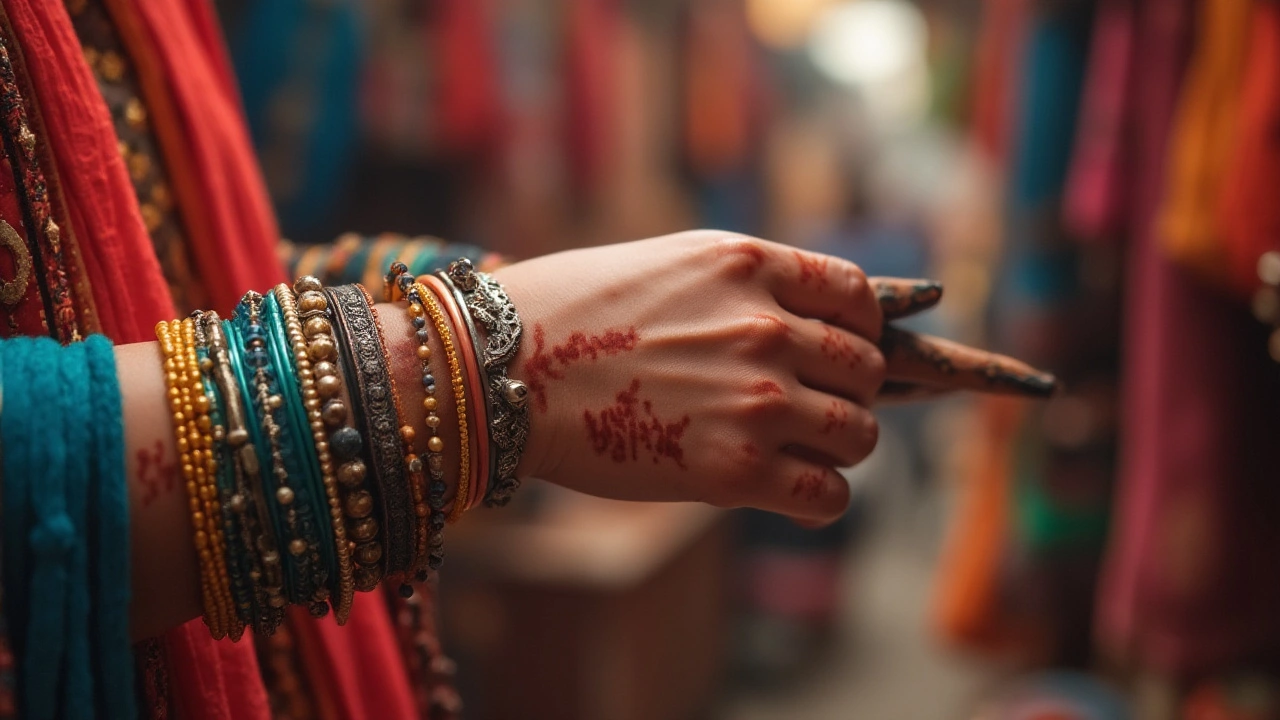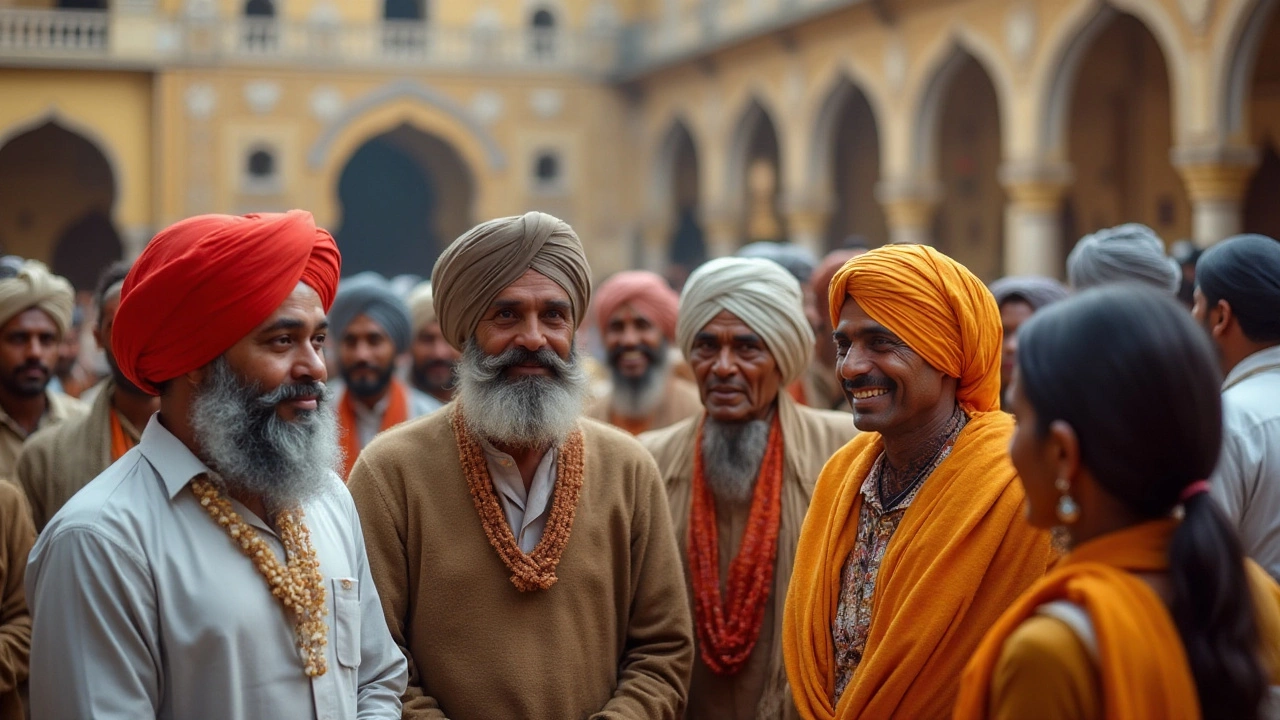
Sikhism, a faith rooted deeply in devotion and discipline, embraces the Five Ks as symbols of faith and commitment. These five articles, mandated by Guru Gobind Singh Ji in 1699, are essential identifiers for initiated Sikhs, known as Khalsa. While each article has its unique significance, our exploration today will focus on how they intertwine with Indian cultural aspects, particularly through traditional jewelry like bangles.
The Five Ks comprise kesh (unshorn hair), kangha (a wooden comb), kara (a steel bangle), kirpan (a ceremonial sword), and kachera (cotton undergarments). Each holds its place in the spiritual and routine life of a Sikh, symbolizing virtues like humility, honesty, and responsibility.
Interestingly, the kara, among these symbols, is akin to traditional Indian bangles, representing both religious faith and cultural heritage. While the kara signifies an unbroken commitment to righteousness, bangles in India reflect unity, protection, and beauty, creating a fascinating intersection of culture and religion. Let's delve deeper into each of these symbols and their poignant meanings, while also appreciating their cultural connotations.
- Introduction to the Five Ks
- Kesh: The Unshorn Hair
- Kangha: The Wooden Comb
- Kara: The Steel Bracelet
- Kirpan and Kachera: Sword and Utility
Introduction to the Five Ks
The Five Ks stand as the cornerstone of Sikh identity, each a symbol enshrined with deep spiritual significance. These symbols are a beacon of faith for those initiated into the Khalsa, a community established by the tenth Sikh Guru. The announcement in 1699 by Guru Gobind Singh Ji firmly entrenched these symbols, birthing a tradition rooted in resistance against oppression and a life committed to truth and justice.
The journey of the Five Ks begins with understanding their tangible and intangible values. These items transcend their physicality, each representing virtues that guide a Sikh's life.
"In the Khalsa, the five articles of faith are treasured not just as identifiers but as conduits of divine connection," explains Professor Harbans Singh, a noted scholar on Sikhism. By adorning these symbols, Sikhs are reminded every day of their promises to live truthful, disciplined, and righteous lives.The Five Ks are not just elements of religious duty; they form the moral gravity wells around which a Sikh's day revolves, granting clarity amidst the complexities of modern existence.
The Importance of Public Identity
The Khalsa, by its very nature, is a collective pledging towards an outward projection of its beliefs. This public demonstration is not only a declaration of religious devotion but also a call to uphold righteousness in a community. Being easily recognizable due to these symbols means upholding dignity and exemplifying virtue in all actions, a task that has cultivated resilience and respect over the centuries. The presence of kesh and the distinctive bangle, kara, are everyday reminders to stay true to one's teachings and responsibilities, an anticipation that transforms their daily lives into devoted acts of service.
Cultural Intersection
This blend of faith into culture becomes particularly evident with the kara, linking Sikh spiritual symbolism with broader Indian traditions such as bangles. Concepts of unity, eternity, and spiritual binding, tied with the circle of metallic strength that a kara represents, resonate similarly with bracelets and bangles in Indian culture. Not just habitual, these adornments connect the ancient elegance with modern significance, a cultural confluence for their communities. The kara is a physical testimony to the Sikh commitment to righteousness and provides a perfect example of spiritual significance meeting cultural beauty at an intersection.
The Khalsa commitment imbues the individual with a lifelong search for higher truth and societal contribution, while the Five Ks continue as significant markers of this journey. In current times, these symbols have transcended their initial religious values, becoming icons of identity and advocacy, harnessing the past's strength while inspiring innovation and acceptance for the future.
Kesh: The Unshorn Hair
Kesh, or the unshorn hair, holds a place of paramount importance in Sikhism. It is one of the most visible and arguably the most spiritually profound of the Five Ks that define the Khalsa identity. The practice of keeping hair uncut is not simply a ritualistic tradition but a deep and abiding commitment to accepting one's natural form as gifted by the divine. It symbolizes a Sikh's respect for the perfection of God's creation, aligning their external appearance with the spiritual tenets of acceptance and humility. The unshorn hair serves as a lifelong testimony to a spiritual discipline that imbues adherence to naturalness as a form of spirituality.
The act of keeping hair unshorn extends beyond mere religious observance—it encapsulates a broader philosophy embracing the acceptance of God's will without alteration. Historically, this practice has unwavering roots dating back to the times of Guru Nanak, the founder of Sikhism, and was formalized by the tenth Sikh Guru, Guru Gobind Singh Ji. During the creation of the Khalsa in 1699, he impressed upon his followers the significance of maintaining kesh as an authentic element of their Sikh identity. Guru Gobind Singh Ji once articulated the significance of this practice by stating,
'Let the believers follow the path of righteousness, carrying the mark of unshorn hair to remain steadfast on their journey.'This simple yet profound commitment binds Sikhs to their faith over the centuries.
Maintaining kesh is a tangible reminder of one’s duty to live a life of integrity, honesty, and self-discipline. It transcends beyond a personal lifestyle choice, influencing societal interactions. As hair is left to grow naturally, Sikhs often braid or cover it with a turban to imbue themselves with pride and dignity. This practice has, through time, become a powerful symbol of identity, distinguishable not just among the Sikh community but on a global level. It often sparks curiosity and admiration, underlining core values of dedication, equality, and identity. In the Indian cultural context, where traditional bangles represent continuity and unity, kesh too reverberates the ideals of integrity and strength, drawing an interesting parallel between cultural and religious symbols.
Interestingly, recent studies have indicated that embracing natural practices such as keeping one's hair unshorn fosters not just spiritual but physical well-being, echoing the traditional wisdom of minimizing interference with nature's design. This cultural and religious allegiance to kesh forms an intricate tapestry woven through daily life, calling upon the bearer to embody resilience and purity. Thus, kesh continues to serve not merely as a religious emblem but as a timeless symbol harmonizing the spiritual with the cultural ethos deeply entrenched within Sikhism, akin to the deep-rooted tradition of wearing bangles in Indian culture.

Kangha: The Wooden Comb
Among the treasured Five Ks of Sikhism, the kangha stands out as a humble yet profound symbol of cleanliness and orderliness. This simple wooden comb is carried by both men and women who have embraced the Khalsa way of life. While its physicality might seem understated, its spiritual significance and practical application resonate deeply with the tenets of the Sikh faith. As an instrument of hygiene, the kangha reminds Sikhs of the importance of keeping both body and mind free from impurities and distractions.
The kangha is usually tucked into the hair or turban, making it accessible for regular use, underscoring the Sikh principle of maintaining inner and outer order. Combing the hair with the kangha symbolizes discipline, a highly valued quality in Sikhism. Its presence encourages daily grooming and self-care, acts that foster self-respect and consciousness of one's actions and appearance. Such practices extend beyond the physical form, serving as a metaphor for inner cleanliness, urging followers to keep their thoughts pure and aligned with the divine.
Historically, the choice of wood for the kangha is profound in itself. Wood, a material connected to nature, reflects simplicity and sustainability, aligning with the Sikh emphasis on humility and environmental stewardship. The kangha, in its modesty, shuns extravagance and conveys a message of simple living and high thinking. This idea, deeply ingrains in Sikh philosophy, encourages adherents to focus on spiritual wealth over material possessions. The kangha's presence within the turban highlights the Sikh value of protecting and maintaining one’s body as a temple.
Sant Teja Singh once said, "With the kangha, we comb through our worldly attachments and untangle the knots that bind us." This powerful metaphor underscores the kangha's spiritual essence, emphasizing its role in helping individuals address and organize their thoughts and emotions.
The cultural implications of the comb go beyond its religious context. In broader Indian culture, combs have been symbolic of structure and order. In many parts of India, similar tools have been used for centuries to promote scalp health and hair maintenance, bridging cultural practices with spiritual ideals. For Sikhs, however, the kangha is a continual reminder of their faith journey, reiterating values such as discipline, purity, and assimilation with nature.
In a world where simplicity often takes a backseat to flamboyance, the humble kangha stands as a testament to the profound impact of simple acts of care and attention. Its bearing in the Sikh community elevates it from mere utility to a cherished symbol of faith. With each stroke, the kangha serves as a gentle nudge to embody the discipline, order, and purity that the Sikh faith exemplifies. As the rhythm of the comb’s strokes mirrors the meditative chants of Sikhs, it ties together tradition, spirituality, and everyday life into a harmonious blend.
Kara: The Steel Bracelet
The kara is much more than just a piece of jewelry; it's a profound symbol of unity and eternity within Sikhism. Made of stainless steel or iron, it holds a circular form which represents the cyclical nature of life, without a beginning or an end. This design choice is not mere aesthetics but an embodiment of the Sikh belief in the timelessness and continuity of the universe. The kara serves as a constant reminder to its wearer of the moral and ethical bounds outlined in Sikh teachings. Historically, it traces back to Guru Gobind Singh Ji, the tenth Guru of Sikhism, who made it part of the daily attire for Sikhs joining the Khalsa brotherhood.
Wearing the kara on the right wrist signifies strength, both internal and external. It encourages Sikhs to engage in righteous action, symbolizing a bond of restraint against evil deeds. There's an interesting parallel here with the use of traditional Indian bangles. While bangles in India are often worn as adornments, their circular shape also stands for love, protection, and well-being, resonating with the spiritual ethos attributed to the kara.
"The kara is a slave's bracelet—reminder we are bound to God." — Guruka Singh Khalsa
Made from materials like steel which resists corrosion, the kara is a constant, durable reminder of the Sikh vow to keep one's actions pure. Its simplicity starkly contrasts with often ornate Indian bangles, yet it shares the spiritual connotation of warding off negativity. Studies have shown that communities sharing symbols such as these live with a more pronounced sense of identity and belonging. An interesting cultural blend can be examined through the lens of Sikh festivals, like Vaisakhi, where the kara's significance comes to the forefront. Festivals become occasions for Sikhs to reflect on their commitment to the tenets of their faith while celebrating their cultural heritage.
For those curious about adopting cultural elements responsibly, understanding the kara's symbolism enriches one's cultural literacy. In today's diverse world, wearables like the kara not only express personal faith but also communicate broader cultural narratives that span centuries. As we appreciate this intricate integration of tradition and symbolism, it is vital to remember the respect and reverence with which a kara is worn within Sikh communities worldwide.

Kirpan and Kachera: Sword and Utility
At the heart of Sikh identity and faith lies the kirpan, a ceremonial sword that resonates with deep symbolism. Originally representing a Sikh's duty to protect the weak and promote justice, the kirpan is a profound symbol of courage and the fight against oppression. Though it's commonly seen as a small sword today, its historical significance stems from times when warriors had to defend the vulnerable. Tracing its origins to Guru Gobind Singh Ji's time, the kirpan reminds Sikhs of their responsibility towards humanity. Interestingly, this emblem of protection finds its parallel in various cultures where swords are symbols of nobility and honor. Throughout history, pieces of literature and art have often depicted swords as divine instruments of righteousness.
The kachera, meanwhile, is a humble piece of clothing that holds profound significance. These plain, cotton undergarments were initially designed for comfort and readiness in combat, enabling swift movement for Sikh warriors. Today, they serve as a reminder of self-discipline and modesty. The kachera's simplicity contrasts with its deep spiritual connotation—serving as a metaphor for purity and straightforwardness in one's actions. It's fascinating to see how this piece of attire speaks to universal values of humility and virtue across various traditions, reiterating the idea that what's beneath the surface often carries the most weight.
"In the Sikh tradition, the kirpan is not merely a weapon but a symbol of the power of truth," explained Gurinder Singh Mann, a prominent scholar in Sikh studies.
Despite their differences in form and function, both the kirpan and kachera are constants in a Sikh’s daily life. They are reminders that faith extends beyond personal spirituality, intertwining with societal responsibilities and moral imperatives. Remarkably, both these symbols underscore the balance between peaceful living and readiness to uphold righteousness, demonstrating a harmony intrinsic to Sikh philosophy. Sikhism's emphasis on protection and humility through these artifacts has inspired countless individuals worldwide, influenced by their call for justice and equality. These enduring symbols continue to captivate and educate those within and outside the Sikh community, serving as universal representations of moral dignity and strength.


